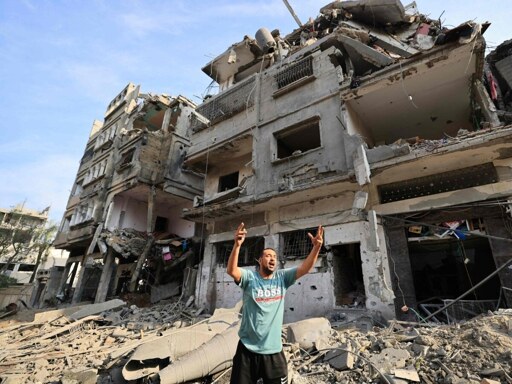With the onset of winter, thousands of families in the Gaza Strip find themselves facing a tragedy that worsens day by day: dilapidated tents that leak rainwater, or destroyed, cracked houses that could collapse on their inhabitants at any moment. Between these two harsh choices, the circle of danger widens with no solution in sight – all thanks to Israel’s ongoing genocide.
Since the Israeli war destroyed tens of thousands of housing units, many displaced people have been forced to return to their damaged homes after being unable to endure the tents, which cannot withstand the cold winter weather and heavy rains. With the continued ban on the entry of new tents and prefabricated caravans, the suffering of families who have lost any safe alternative is deepening.
Last week, a building in Al-Shati camp in Gaza collapsed on its residents, prompting civil defence crews to rush to rescue those trapped under the rubble, resulting in injuries to several family members. Prior to that, several buildings collapsed across the Strip, some of which left casualties, while thousands of residents remain at risk of collapse at any moment.
Fear renews itself every moment in Gaza
In the Al-Zaytoun neighbourhood, the family of Khalil Youssef, 48, lives in constant anxiety because of a neighbouring four-storey building that has been destroyed by air strikes and is on the verge of collapse. Khalil says his family hears ‘knocking’ and strange noises coming from inside the cracked building, while stones constantly fall in front of their home. Despite the direct threat to their children as they pass by, the family has no other choice as the cold intensifies and alternative shelter is difficult to find.
In the Tuffah neighbourhood of Gaza, Abu Anas sits among the rubble of his home near a small stove, trying to warm his three children. ‘The first night of rain was disastrous… The walls cracked, and we heard breaking sounds inside the ceiling. But this situation is still better than a tent,’ he says, pointing to three rooms he had to close after parts of their ceilings collapsed.
Local engineering estimates indicate that thousands of homes have become uninhabitable due to cracks, subsiding foundations and damaged columns. Official data indicates that around 400,000 housing units are out of service, equivalent to 80% of the sector’s total of 500,000 units. More than 20,000 homes need to be demolished immediately due to the extreme danger they pose, while many are inhabited by displaced persons who have no alternative.
With the onset of winter in Gaza, the risks are exacerbated, as torrential rains and strong winds cause soil erosion that may threaten the remaining stability of cracked buildings. This is forcing large numbers of families to leave their inadequate tents and seek shelter from the cold in damaged concrete houses, even though this option puts them at risk of death.
Warnings go unheeded
The Civil Defence Authority in Gaza has warned of an immediate danger to residents due to thousands of houses that are in danger of collapsing. The authority’s spokesperson, Mahmoud Basal, said that dozens of citizens have died and hundreds have been injured as a result of collapsed buildings, calling on residents to stay away from them as much as possible and seek refuge in available shelters.
Basal explained that Gaza City is the most affected, confirming that the threatened buildings are concentrated in the neighbourhoods of Al-Tuffah, Al-Zaytoun, Al-Rimal, Al-Zarqa and Al-Shati camp—the same areas that have recently seen intense military operations. He added that the lack of alternatives and the occupation’s refusal to allow tents and caravans to be brought in is forcing residents to return to dangerous buildings, despite the direct threat to their lives.
While working in the Zarqa area, civil defence crews documented a number of citizens injured after two houses collapsed, while others were injured in Al-Shati camp as a result of a cracked building collapsing.
The agency called on the international community to shoulder its responsibilities and exert pressure to provide safe and rapid alternatives, such as insulated tents, caravans and temporary shelters, until reconstruction can begin.
With a harsh winter expected, experts warn of an impending humanitarian disaster unless corridors are opened to bring in basic supplies or urgent solutions are found to save thousands of families caught between the danger of collapse and the harshness of displacement.
Amidst the rubble of homes and the cold of tents, one question remains unanswered in Gaza: how long can people live on the brink of death?
Featured image via the Canary
By Alaa Shamali
From Canary via this RSS feed


